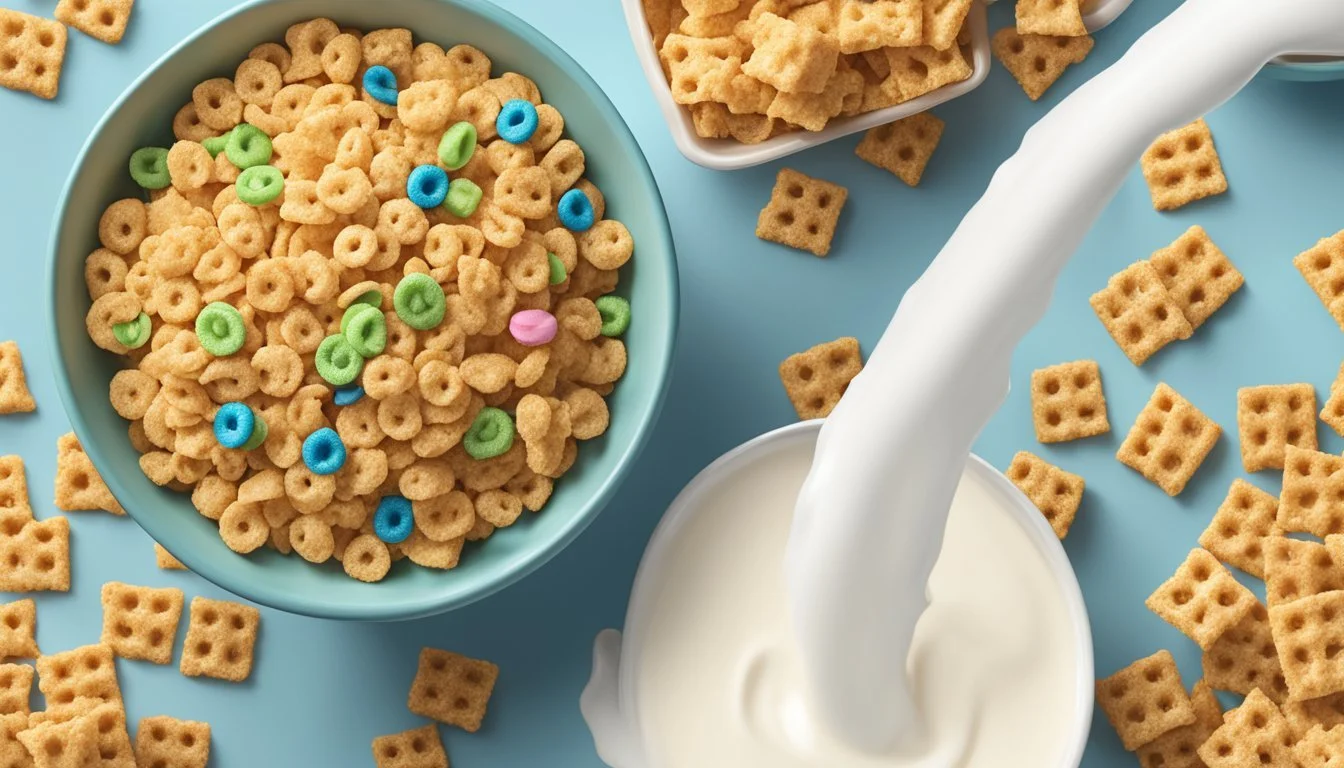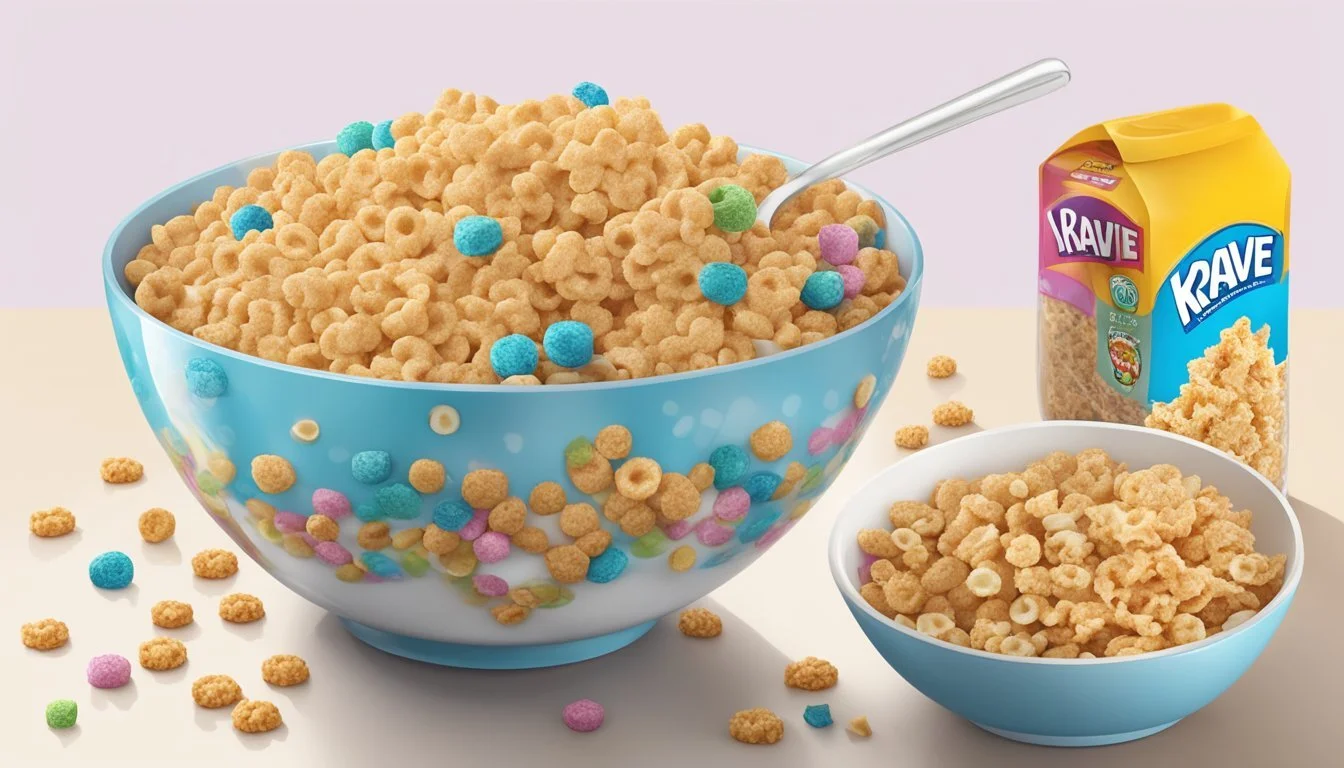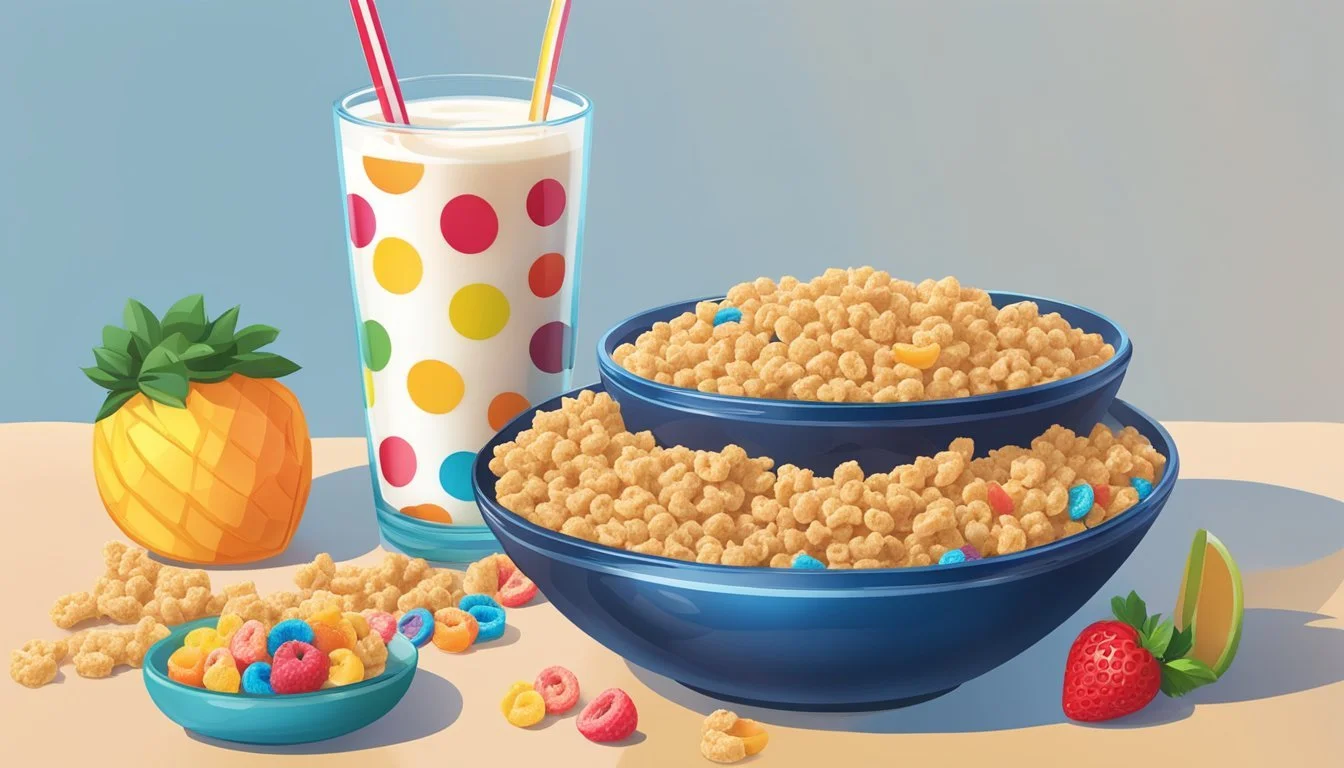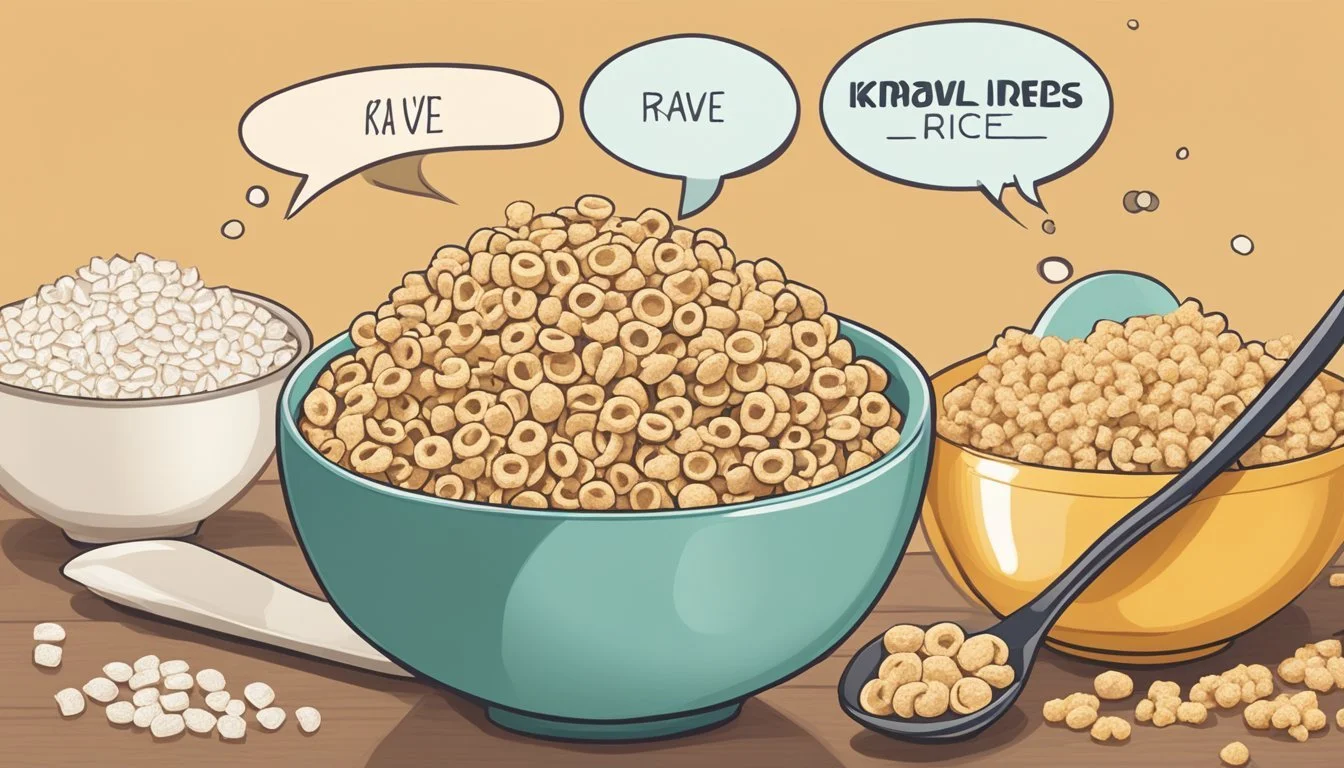Krave vs Rice Krispies
A Breakfast Cereal Showdown
This Article is Part of Our Breakfast Cereal Guide with Details on Krave Nutrition and Rice Krispies Nutrition
When it comes to choosing between two popular breakfast cereals, Krave and Rice Krispies, many wonder which one stands out as the healthier option. Both cereals offer unique flavors and textures, appealing to different tastes. For those seeking a snack that doubles as a treat, Krave, with its chocolate-filled centers, provides a delightful surprise. Conversely, Rice Krispies are known for their simplicity and versatility, often used in homemade treats like Rice Krispies squares.
Nutritionally, Rice Krispies may seem like the better option for those mindful of their sugar intake. Krave cereal tends to have more sugar per serving, while Rice Krispies is recognized for its lower sugar content, making it a preferable choice for those monitoring their sugar consumption. Additionally, Rice Krispies often come with the benefit of fewer calories, which can be an essential factor for those on a calorie-controlled diet.
While Krave offers a richer taste experience, Rice Krispies stands out for its wholesome, straightforward ingredients, making it a versatile option in the realm of cereals. This comparison not only highlights the contrast in taste and texture but also underscores the nutritional considerations that might influence a consumer's choice.
Historical Context
Krave and Rice Krispies, both popular cereals made by Kellogg's, have unique origins that speak to their distinct places in breakfast history.
Origins of Krave Cereal
Krave, a chocolate-filled cereal, was launched by Kellogg's in the United Kingdom in 2010. Initially marketed with the slogan "Taste Unleashed", the product quickly gained a following due to its unique combination of crunchy exterior and creamy chocolate interior.
The cereal's innovative design and distinct flavor profiles appealed primarily to younger demographics seeking a snack-like breakfast option. Over time, Krave continued to evolve and expand into various markets, adopting new slogans such as "Here Choccy Choccy" and "It's Time To Melt".
Despite its relatively recent introduction, Krave has managed to carve out a niche in the competitive cereal market, securing its spot on breakfast tables around the world.
The Creation of Rice Krispies
Rice Krispies were introduced by Kellogg’s in the late 1920s. Developed at their Battle Creek, Michigan factory, this cereal was made of crisped rice and became a staple in many households due to its unique texture and “snap, crackle, pop” sound.
Kellogg's innovative approach to cereal creation and marketing played a crucial role in Rice Krispies' success. Over decades, the cereal maintained its popularity and was further cemented into American culture with the invention of Rice Krispies Treats by a Kellogg's recipe tester.
Throughout its history, Rice Krispies faced challenges, including a controversy in 2010 with the FTC over misleading health claims. Despite this, it remains one of Kellogg’s best-selling products and a classic choice for breakfast cereal enthusiasts.
Cereal Composition
When comparing Krave and Rice Krispies, it's essential to examine their ingredients. Understanding what goes into each cereal can help consumers make informed choices based on nutritional value and dietary preferences.
Krave Ingredients Profile
Krave is known for its chocolate-filled centers, which make it a unique choice among cereals. This cereal primarily consists of whole grain wheat, sugar, chocolate, vegetable oil, and corn syrup.
Whole grains are the first ingredient, providing some nutritional benefits, including fiber. Sugar is a prominent component, contributing to both flavor and calorie content. The inclusion of chocolate gives Krave its distinctive taste but also adds to its sugar and calorie count.
Additives like artificial flavors and preservatives are used to enhance taste and shelf-life. Overall, Krave offers a treat-like experience but with relatively high sugar and fat levels compared to more traditional cereals.
Rice Krispies Ingredients Breakdown
Rice Krispies are a staple in many households, known for their simple and crispy texture. The primary ingredient is milled rice, supplemented with sugar, salt, and added vitamins and minerals.
Milled rice forms the backbone, offering a base rich in complex carbohydrates. A moderate amount of sugar contributes to sweetness but keeps the cereal lighter in calories compared to Krave. Salt enhances taste without overpowering the simple flavor profile.
Enrichment with vitamins and minerals, including vitamin D and iron, aims to boost the cereal's nutritional value. Fewer additives make Rice Krispies a more straightforward option for those seeking a less processed cereal.
Nutritional Information
When comparing Krave and Rice Krispies, it's important to evaluate the nutritional value of each cereal. Key factors include calories, protein, fat, fiber, and sugar content, along with other essential nutrients.
Analyzing Krave's Nutritional Value
Krave Chocolately Cereal by Kellogg's offers a unique taste but also comes with specific nutritional facts. A single serving (1 cup) of this cereal contains about 120 calories. It provides about 2 grams of protein.
Fat Content:
Total Fat: 3 grams
Saturated Fat: 1.5 grams
Carbohydrates and Sugar:
Total Carbohydrates: 27 grams
Fiber: 1 gram
Added Sugars: 13 grams
Other Nutrients:
Contains whole wheat flour, whole grain oat flour, and rice flour
Includes vitamins and minerals such as iron and B vitamins
Krave also contains ingredients like chocolate, soy lecithin, palm oil, and natural flavors. It is crucial to consider the added sugars and saturated fat when evaluating its overall healthiness.
Understanding Rice Krispies' Nutritional Content
Rice Krispies by Kellogg's is a staple breakfast cereal known for its simplicity. A serving size of 1 cup (28 grams) provides around 107 calories and relatively low-fat content.
Fat Content:
Total Fat: 0.1 grams
Saturated Fat: 0 grams
Carbohydrates and Sugar:
Total Carbohydrates: 24 grams
Fiber: 0.1 grams
Added Sugars: 4 grams
Other Nutrients:
Primarily made from puffed rice, providing essential nutrients such as vitamin D, iron, and B vitamins
Fortified with additional nutrients to enhance its nutritional profile.
Although Rice Krispies have lower sugar content compared to Krave, they also have minimal fiber and protein. Evaluating these factors can help determine which cereal fits better into a balanced diet.
Culinary Uses
Krave and Rice Krispies both find diverse culinary applications. Krave is often integrated into more indulgent, dessert-focused recipes, while Rice Krispies serve as a foundational element in various innovative treat recipes.
Krave in Recipes
Krave cereal, with its chocolate-filled centers, lends itself well to decadent desserts. Recipes often utilize Krave in no-bake desserts, where it can be combined with peanut butter, chocolate, and caramel for rich, layered bars.
It also works great in milkshakes or as a topping for ice cream and yogurt parfaits. For a creative twist, Krave can be used instead of traditional crust in baking, offering a unique, chocolatey crunch to pies and cheesecakes.
Rice Krispies Treats Innovations
Rice Krispies, known for their light and crispy texture, are a staple in various crispy rice treats. Enhancements to the classic recipe often include browning the butter to create a richer, nutty flavor, adding vanilla extract for depth, or incorporating salt to balance the sweetness.
For more adventurous takes, popular variations include mixing in honey, peanut butter, or marshmallows to achieve different textures and flavors. Additionally, scotcheroos—a combination of Rice Krispies, peanut butter, and chocolate—are a favorite among dessert enthusiasts, offering a satisfying crunch and sweetness.
Consumer Experience
Krave and Rice Krispies are both popular choices for breakfast cereals, but they offer different experiences in terms of taste and texture. This comparison will provide valuable insights for those trying to decide between the two.
Taste Test: Krave vs Rice Krispies
Krave offers a rich, chocolatey taste that appeals particularly to those with a sweet tooth. Each piece is filled with a creamy chocolate center, providing a burst of flavor with every bite.
Rice Krispies, on the other hand, have a more subtle flavor. They are slightly sweet with a hint of malt, making them a versatile option that pairs well with milk, fruit, or as a base for treats like Rice Krispies Treats.
Both cereals bring unique taste experiences. Krave is indulgent and dessert-like, while Rice Krispies are light and straightforward.
Texture and Consistency Comparison
The texture of Krave is chewy, with a crispy exterior and a soft, gooey center. The robust texture makes it feel more like a treat than a traditional cereal.
Rice Krispies are known for their iconic crispy and airy texture. When combined with milk, they maintain a gentle crunch before quickly softening.
Krave's chewiness contrasts sharply with Rice Krispies’ crispiness, offering two distinctly different consumer experiences. Each brings its own charm, depending on whether someone prefers a more indulgent treat or a classic, light cereal.
These differences in texture and consistency play a significant role in the overall enjoyment of these cereals.
Preparation Techniques
To make the most out of Krave and Rice Krispies Treats, it's important to focus on key preparation techniques that enhance flavor and texture. For Krave cereal, keeping the crunch intact is crucial, while for Rice Krispies Treats, the correct mixture and melting process ensure the best results.
Optimizing Krave's Crunchiness
Krave cereal benefits from minimal preparation, but keeping it crunchy involves important steps. Storage plays a key role. Storing Krave in an airtight container maintains its crisp texture. Toppings or add-ins, such as chocolate chips, can be added just before serving to avoid sogginess.
Another method to preserve crunch is to toast the cereal lightly in a preheated oven for a few minutes. This dries out any residual moisture. When using Krave in recipes, make sure to incorporate it immediately before serving to keep it from absorbing moisture.
Perfecting Rice Krispies Treats
Perfect Rice Krispies Treats combine a delicate balance of ingredients and precise mixing techniques. Use fresh marshmallows and melt them together with salted butter for a robust flavor. Brown the butter slightly by letting it sit in the pot until golden and fragrant, which adds a nutty depth to the treats.
Incorporate a pinch of kosher salt while melting the butter and marshmallows to balance the sweetness. Opt for mini marshmallows which melt more uniformly. Use a rubber spatula greased with a butter wrapper to prevent stickiness when mixing. Adding a small amount of vanilla extract can elevate the flavor.
When the mixture is ready, press it into the pan using a piece of waxed paper or another greased spatula to ensure it spreads evenly without sticking. Store the treats in an airtight container to maintain freshness. To vary the texture and flavor, consider mixing in chocolate chips or other add-ins like crushed cookies or sprinkles.
Market Trends
The market for breakfast cereals, particularly Krave and Rice Krispies, is influenced by evolving consumer preferences and continuous product innovations. These factors shape the popularity and competitive landscape of these brands.
Consumer Preferences Shift
Consumer preferences in the cereal market have shifted noticeably in recent years. There is an increasing demand for healthier, more nutritious options, pushing brands like Rice Krispies to innovate and offer gluten-free and lower-sugar variants.
The trend towards simple, clean ingredients has also made traditional cereals like Rice Krispies more appealing. In contrast, Krave is often chosen by those seeking indulgent, dessert-like cereals.
Meanwhile, there's a growing interest in plant-based and organic products across the cereal sector, influencing both brands to consider such avenues for their future product lines.
Cereal Innovations and Variants
Innovation plays a crucial role in maintaining and expanding market share. Rice Krispies has launched various product variants including Rice Krispies Treats and flavored editions to cater to different consumer tastes.
Krave has introduced multiple flavors and formulations, focusing on delivering a unique taste experience with each variant.
Both brands have ventured into more convenient snack formats, adapting to the increasing demand for on-the-go breakfast options. Investments in marketing and new product development reflect these trends, aiming to capture and retain consumer interest through dynamic, innovative offerings.
Health and Diet Considerations
For those analyzing Krave and Rice Krispies in the context of health and diet, several factors come into play. These include the nutrient content, fiber, and presence of added sugars in each cereal.
Krave's Place in a Balanced Diet
Krave cereal often stands out for its chocolate-filled centers, which can be appealing but also lead to a higher amount of added sugar. Nutritionists point out that while Krave is a treat for the taste buds, its high sugar content may not make it the best choice for a daily breakfast.
While it does provide some essential nutrients, the overall low fiber content means it may not keep you as satiated as whole grain options like oatmeal. Those monitoring their calorie intake should consider the higher calorie density of Krave compared to other cereals. This makes portion control crucial for those aiming for a balanced diet.
Rice Krispies as a Healthy Option
Rice Krispies are often marketed as a lighter cereal choice, making them an option for those watching their weight due to their low-calorie and low-fat content. However, they often lack significant fiber, which is important for a healthy breakfast to keep one full longer.
Adding fresh fruits, nuts, seeds, or using low-sugar milk alternatives can enhance their nutritional value. From a dietary standpoint, while they may not be the most nutrient-dense option, Rice Krispies provide a versatile base that can be tailored to fit a balanced diet.
Portion control is important here as well, especially to avoid excess sugar if additional toppings or sweeteners are used.
Tips and Tricks
Understanding the best ways to enhance the experience of eating Krave and Rice Krispies can make a significant difference. Key strategies involve both optimizing the way cereals are enjoyed and adding creative twists.
Enhancing Cereal Experience
When it comes to improving your cereal, consider the texture and flavor balance. Krave cereals, with their chocolate filling, benefit from a mix of milk and yogurt. This combination melds creaminess with the cereal's crunch. For Rice Krispies, the trick lies in maintaining their signature crunch. Use cold milk to prevent them from sogging quickly.
Another tip is portioning. For an on-the-go option, create individual servings in resealable bags. Adding raisins or pecans to both cereals can introduce additional textures and flavors. Nuts bring a satisfying crunch and a bit of protein, making your breakfast more filling.
Creative Additions and Substitutions
Rice Krispies can be transformed with add-ins and substitutions. Mixing in chocolate chips, dried fruits like raisins, or even shredded coconut can elevate this simple cereal. For a unique twist, substitute half of the cereal with crushed graham crackers, creating a s'mores-inspired dish.
Krave pairs well with fresh berries or sliced bananas, enhancing the chocolate flavor. For an indulgent treat, drizzle a bit of honey or add a spoonful of peanut butter. This not only ramps up the flavor but also adds nutritional value.
Experimenting with your milk choice can also alter the experience. Almond milk, soy milk, or even chocolate milk can change the taste profile significantly. This kind of customization ensures every bowl offers a new and exciting taste adventure.
Consumer Opinions and Reviews
Consumer feedback on Krave and Rice Krispies varies, with each cereal having distinct advantages and specific traits appreciated by fans.
Product Reviews for Krave
Krave receives varied consumer opinions, often praised for its chocolatey taste and crunchiness. The chocolate flavor builds up with each bite, providing a rich and satisfying experience.
The cereal maintains its crunchiness well in milk, which is a notable point in many reviews. Its enriched with 8 vitamins and minerals which boost its nutritional profile. Some consumers mention it as a great snack any time of the day, from an office treat to a post-workout bite.
Nonetheless, a few reviewers point out that the texture can be quite chewy, likening it to a chocolate bubblegum niblet. Despite this, many enjoy eating chocolate for breakfast, which distinguishes Krave from other options.










